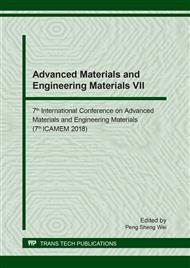[1]
Harada M, Hayashi Y, Hayashi T, et al. Effect of moisture content of members on mechanical properties of timber joints, J. Journal of wood science. 2005, 51(3): 282-285.
DOI: 10.1007/s10086-004-0656-9
Google Scholar
[2]
Yue Z. Traditional chinese wood structure joints with an experiment considering regional differences, J. International Journal of Architectural Heritage. 2014, 8(2): 224-246.
DOI: 10.1080/15583058.2012.688179
Google Scholar
[3]
Xie Q F, Du B, Xiang W, et al.Experimental study on seismic behavior and size effect of dovetail mortise-tenon joints of ancient timber buildings, J. Journal of Building Structure. 2015, 36(03): 112-20.
Google Scholar
[4]
Chen C C, Qiu H X, Bao Y N. Study on the flexural mechanical model of straight mortise-tenon joints in the base of melon-column, J. Journal of Hunan University. (2015).
Google Scholar
[5]
Song X, Jingyu S U, Guo X, et al. A review of research on seismic performance of mortise-tenon joints in chinese ancient timber buildings, J. World Earthquake Engineering. 2014, 30(1):12-22.
Google Scholar
[6]
Chen C C, Qiu H X, Xu M G. Experimental study on flexural behavior of typical mortise-tenon joints, J. Applied Mechanics & Materials. 2014, 578-579:160-163.
DOI: 10.4028/www.scientific.net/amm.578-579.160
Google Scholar
[7]
Rohana H, Azmi I, Zakiah A. Shear and bending performance of mortise and tenon connection fastened with dowel, J. Journal of Tropical Forest Science. 2010, 22(4):425-432.
Google Scholar
[8]
Judd J P, Fonseca F S, Walker C R, et al. Tensile strength of varied-angle mortise and tenon connections in timber frames, J. Journal of Structural Engineering. 2012, 138(5):636-644.
DOI: 10.1061/(asce)st.1943-541x.0000468
Google Scholar
[9]
Chun Q, Meng Z, Han Y. Research on mechanical properties of main joints of chinese traditional timber buildings with the type of post-and-lintel construction, J. International Journal of Architectural Heritage. (2016).
DOI: 10.1080/15583058.2016.1204487
Google Scholar
[10]
Zhao H T, Zhang H Y, Xue J Y, et al. The stiffiness analysis on the characteristic of mortise-tenon joint in historical timber buildings, J. Journal of Xian University of Architecture & Technology. 2009, 41(4):450-454.
Google Scholar
[11]
Sandberg L B, Bulleit W M, Reid E H. Strength and stiffness of oak pegs in traditional timber-frame joints, J. Journal of Structural Engineering. 2000, 126(126):717-723.
DOI: 10.1061/(asce)0733-9445(2000)126:6(717)
Google Scholar
[12]
Ebrahimi G, Eckelman C A, Derikvand M. Bending moment capacity of mortise and loose-tenon joints, J. Wood & Fiberence. 2014, 46(2):159-166.
DOI: 10.1007/s11676-014-0479-5
Google Scholar
[13]
Shi Y J, Cheng M, Wang Y Q. Application and study of aluminum alloy in building structures, J. Building Science. (2005).
Google Scholar
[14]
Cheng M, Shi Y J, Wang Y Q. Connection of aluminum members and design method, J. Building Science. (2006).
Google Scholar
[15]
Xiao S N, Jia Y. Strength analysis of rivet and bolt joint structure in aluminum alloy car body of high-speed train, J. Electric Locomotives & Mass Transit Vehicles. (2004).
Google Scholar
[16]
Paik J K. Mechanical properties of friction stir welded aluminum alloys 5083 and 5383, J. International Journal of Naval Architecture & Ocean Engineering. 2009, 1(1):39-49.
DOI: 10.3744/jnaoe.2009.1.1.039
Google Scholar
[17]
Baldan A. Adhesion phenomena in bonded joints, J. International Journal of Adhesion & Adhesives, 2012, 38(4):95-116.
DOI: 10.1016/j.ijadhadh.2012.04.007
Google Scholar


